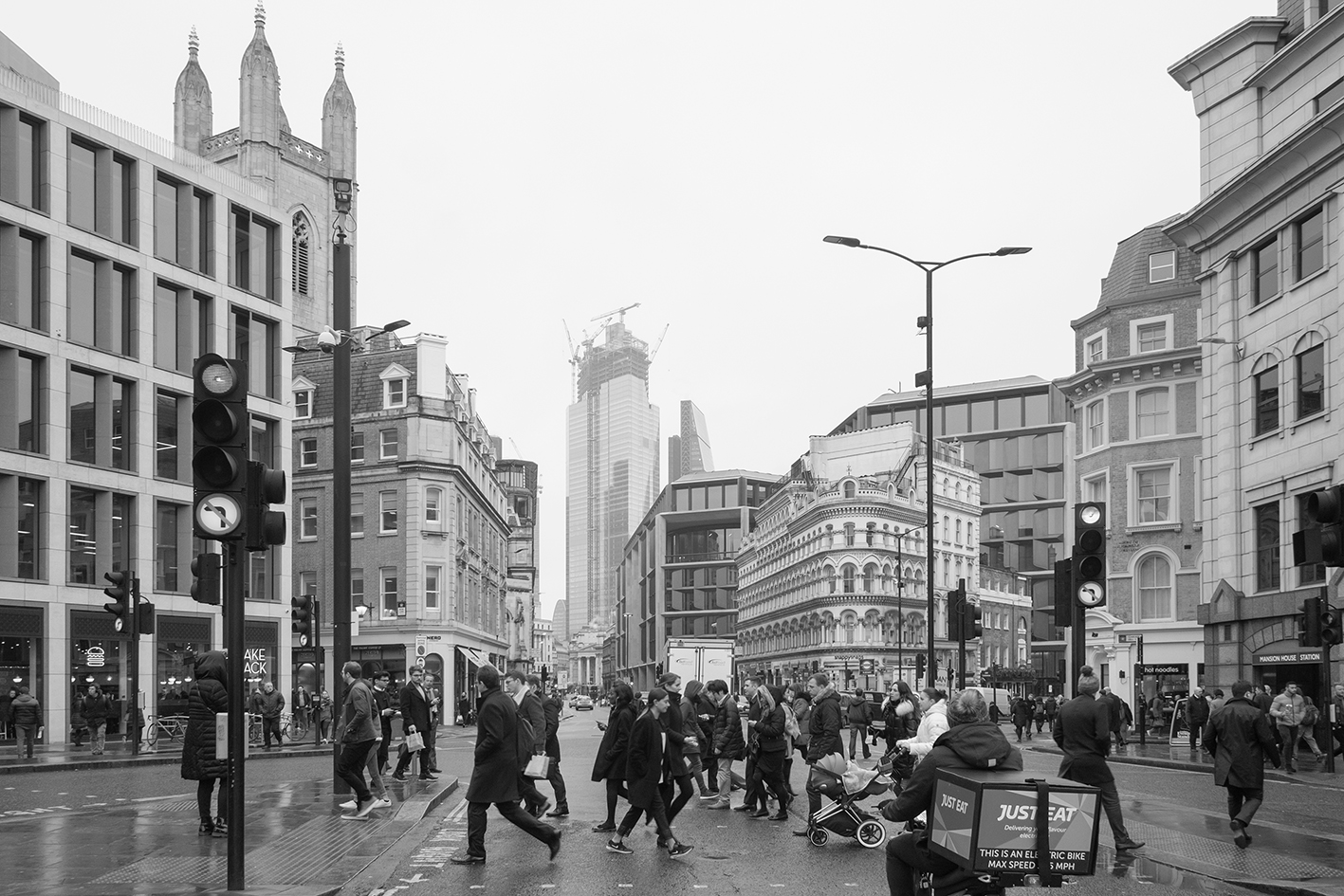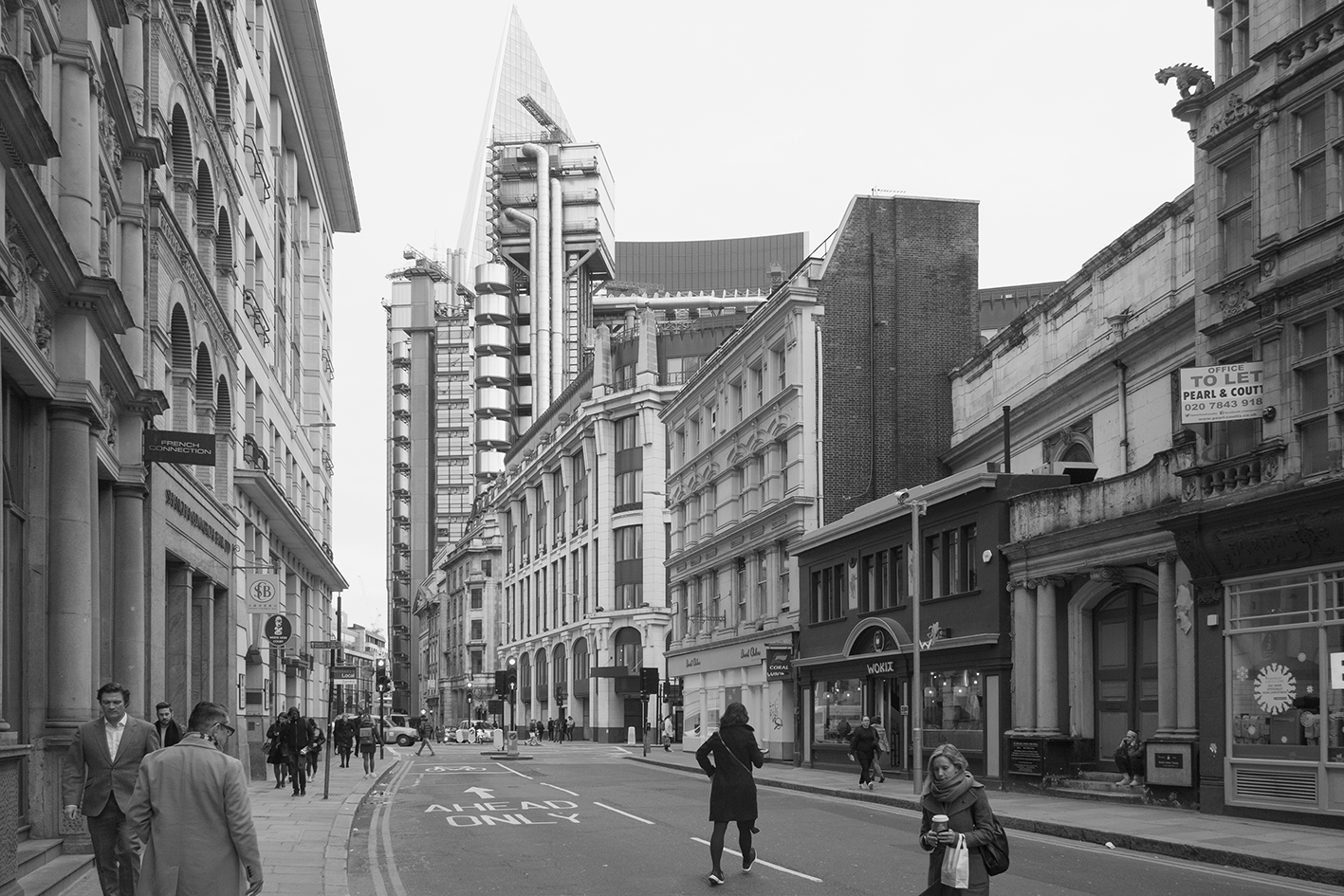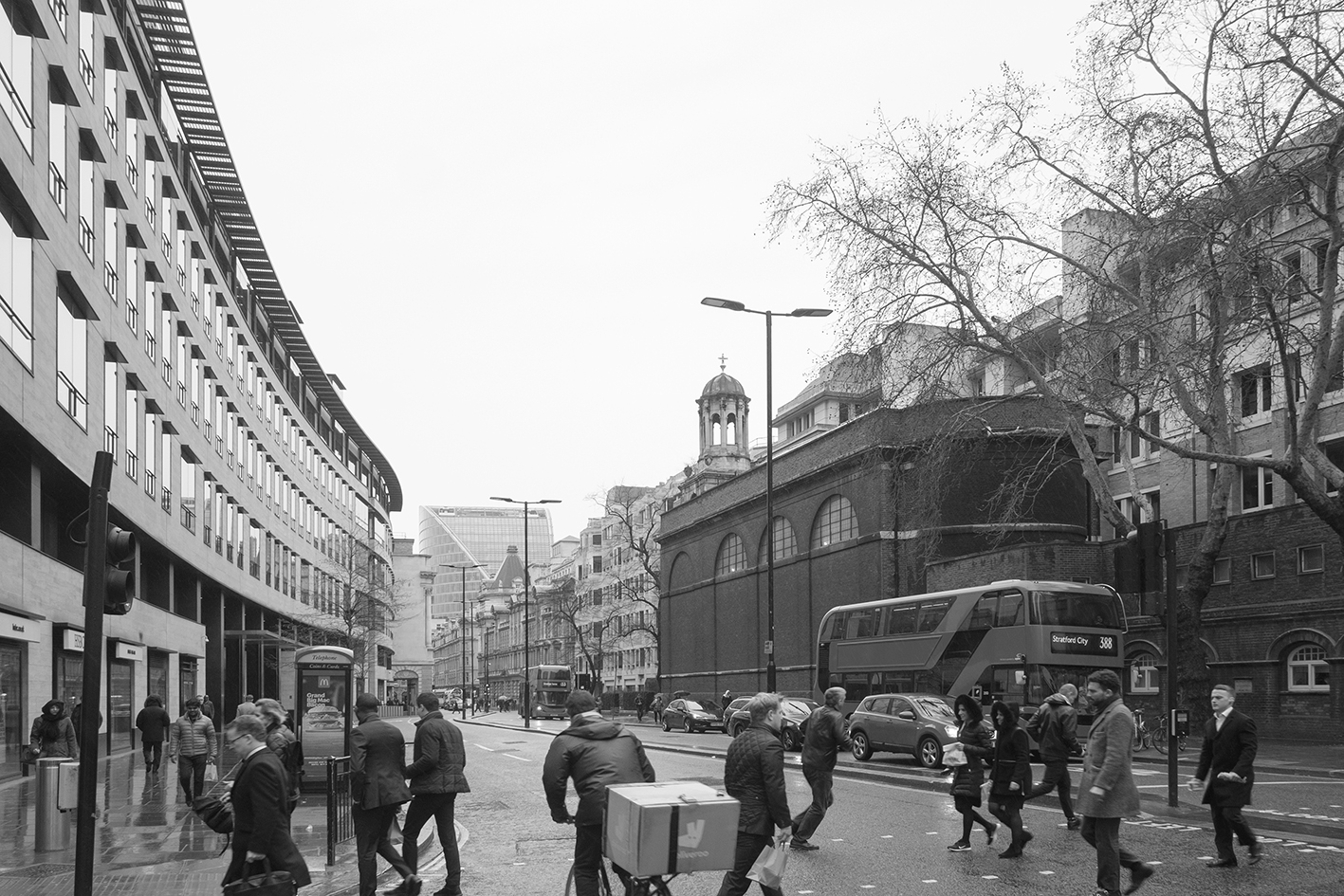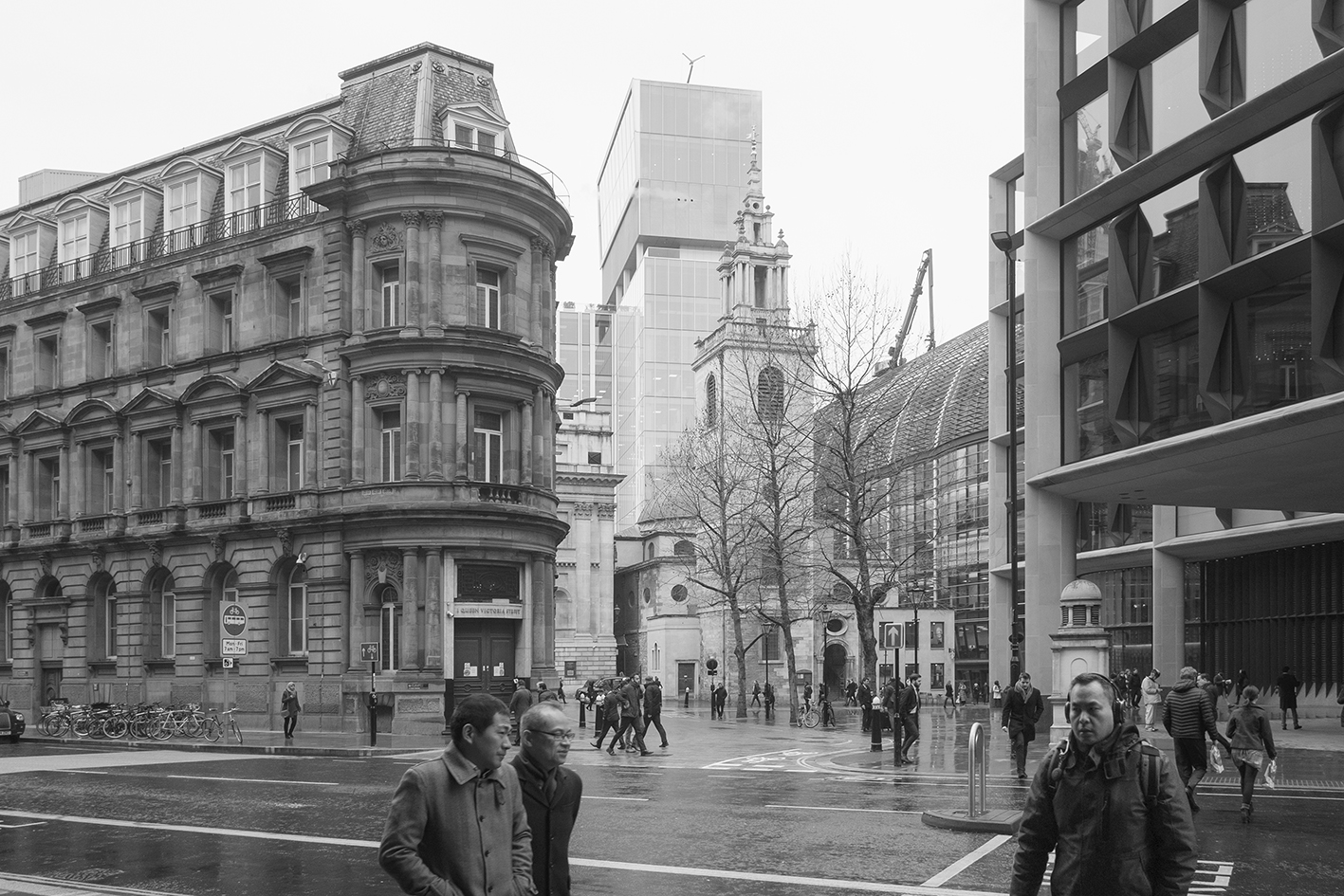City of London
(2018 / 19)

Sinopsis
La serie “City of London” explora el corazón financiero de Londres como ejemplo de la grandilocuencia con la que el poder se afirma a sí mismo a través de la forma urbana. El trabajo destaca el entrelazado simbólico y arquitectónico entre la ciudad histórica y la financiera.
La City, tal cómo se nos presenta hoy, es el resultado del cambio de paradigma económico que en la década de 1980, llevó a liberalizar el sistema bancario colocando las finanzas en el centro del tablero económico. Ante la pérdida de influencia británica en la economía global tras la desintegración del Imperio y las sucesivas crisis de la década de 1970, la libertad operativa del sector financiero fue presentada como una cuestión de necesidad.
Como centro financiero la City cumple la doble función de ser el motor económico de la ciudad y el baluarte de la supremacía monetaria británica en el mundo. Como núcleo urbano y conjunto arquitectónico, mantiene una relación instrumental con la ciudad histórica sobre la que se levanta y en la que busca su legitimación. En la City se expresa una continuidad artificial entre la idea de progreso histórico y la doctrina económica neoliberal. El libre mercado como camino hacia la realización histórica es una idea que ha sido plasmada con gran talento y eficacia por arquitectos de la talla de James Stirling, Richard Rogers o Norman Foster.
Abstract
The series "City of London" explores the financial heart of London as an example of the grandiosity with which power asserts itself through urban form. The work highlights the symbolic and architectural interweaving between the historic and financial city.
The City, as it is presented to us today, is the result of the economic paradigm shift that in the 1980s led to the liberalization of the banking system, placing finance at the center of the economic board. Faced with the loss of British influence in the global economy after the disintegration of the Empire and the successive crises of the 1970s, the operational freedom of the financial sector was presented as a matter of necessity.
As a financial center, the City serves the dual function of being the economic engine of the nation and the bulwark of British monetary supremacy in the world. As an urban nucleus and architectural ensemble, it maintains an instrumental relationship with the historic city on which it stands and in which it seeks its legitimacy. In the City, an artificial continuity is expressed between the idea of historical progress and neoliberal economic doctrine. The free market as a path to historical realization is an idea that has been skillfully and effectively embodied by architects of the caliber of James Stirling, Richard Rogers, or Norman Foster.

Monument to the Great Fire of London (Christopher Wren and Robert Hooke, 1671) at Fish St Hill.

In the background, left to right: Leadenhall St towards Lime Square with St Mary Axe. 52 Lime St (The Scalpel, Kohn Pedersen Fox, 2018), 122 Leadenhall (‘The Cheesegrater’, Rogers Stirk Harbour + Partners, 2014) and 22 Bishopsgate (PLP Architects, under construction). St Katharine Cree (unknown architect, 1630) in the foreground.

St Paul’s Cathedral (Christopher Wren, 1720) and 1 New Change Shopping Centre (Jean Nouvel, 2010) seen from Watling St with Bread St.

A view of Liverpool Street from Liverpool Street Train Station.

30 St Mary Axe (‘The Gherkin’, Foster + Partners, 2003) seen from Mark Lane towards Fenchurch Street.

The A10 Road stretch to Norton Folgate and Bishopsgate seen from Shoreditch High Street with Commercial and Great Eastern St.

Bank Junction seen from Mansion House St.

Bank Junction seen from the Royal Exchange Building. From left to right: Mansion House (Lord Mayor’s official residence, George Dance the Elder, 1739), 1 Poultry (James Stirling, 1997), 1 Prince’s St (National Provincial Bank Building, NatWest, Edwin Cooper, 1932), Threadneedle St (Bank of England, George Sampson, 1734 / John Soane, 1828 / Herbert Baker, 1939). Monuments: Equestrian statue of the Duke of Wellington (Francis Leggett Chantrey, 1844), London Troops War Memorial (Alfred Drury, Aston Webb, 1920).

A view of 110 Bishopsgate (the Heron Tower, KPF Kohn Pedersen Fox, 2011) and 60-70 St Mary Axe (the ‘Can of Ham’, Foggo Associates Architects, under construction) from Bevis Marks.

Bishopsgate with Brushfield St.

31-35 Fenchurch St (Plantation Place, Arup Group, 2004) seen from East Cheap with Rood Lane.

A view from Eldon with Broad St. On the left in the foreground, 100 Liverpool St (Hopkins Architects, under construction). In the background from left to right: 99 Bishopsgate (GMW Architects, Gollins Melvin Ward, 1976), 22 Bishopsgate (PLP Architects, under construction), and 25 Old Broad St (Tower 42 / NatWest Tower, Richard Seifert, 1980)

A view of Queen Victoria St with Cannon St. From left to right: 45 Cannon St (Fletcher Priest, 2016), St Mary Aldermary (Christopher Wren, 1704), 22 Bishopsgate (PLP Architects, under construction) and 3 Queen Victoria St (Bloomberg European HQ, Foster + Partners, 2017).

60 Queen Victoria St (Foggo Associates, 1999) and 3 Queen Victoria St (Bloomberg European HQ, Foster + Partners, 2017) seen from Watling St.

1 Lime St (Lloyd’s Building, Richard Rogers, 1986) seen from Leadenhall St.

Ropemaker St with Moorgate and Finsbury Pavement from South Pl.

A view from London Wall with Moorgate. From left to right: 1 Coleman St (Swank Hayden Connell Ltd, 2007), London Wall Place (Make Architects, 2017) and Moor House (Foster + Partners, 2005).

110 Bishopsgate (Heron Tower, KPF Kohn Pedersen Fox, 2011) and a section of the Bishopsgate Pedway from Tower 42 to Broad St House seen from Wormwood St with Old Broad St.

A view of Liverpool Station’s wall (Edward Wilson and Lucas Brothers, 1874) in Sun St Passage. The 25 Old Broad St (Tower 42 / NatWest Tower, Richard Seifert, 1980) is in the background and the 5 Broadgate (UBS HQ, Make Architects, 2015) on the right.

A view of London Wall. From left to right: 1 Great Winchester St (Winchester House, Deutsche Bank HQ, David Walker Arquitects, 1998), 117 London Wall (Moor House, Foster + Partners, 2015) and All Hallows-on-the-Wall Church (George Dance the Younger, 1776).

22 Bishopsgate (PLP Architects, under construction), 122 Leadenhall (‘The Cheesegrater’, Rogers Stirk Harbour + Partners, 2014) seen through the plot left after the demolition of 6-8 Bishopsgate and 150 Leadenhall St.

1 Ropemaker St. (The City Point, F. Milton Cashmere and H. N. W. Grosvenor, 1967 / Refurbished by Sheppard Robson in 2000) seen through 1 London Wall Place (Make Architects, 2017) from London Wall.

Walbrook with Bucklersbury seen from Queen Victoria St. From left to right: 1 Queen Victoria St (City of London Magistrates Court, New Zeland Bank between 1889-1988), St Stephen Walbrook Church (Reconstruction by Christopher Wren in 1679 after the Great Fire), New Court (Rothschild’s Bank London HQ, OMA, 2011) and 3 Queen Victoria St (Bloomberg European HQ, Foster + Partners, 2017).

The A10 Road stretch from Gracechurch St with Eastcheap to Bishopsgate.

1-2 Broadgate (Arup Architects, 1987 / the building is set to be vacated mid-2020. A new interior development by Alford Hall Monaghan Morris has been commissioned) and 5 Broadgate (UBS HQ, Make Architects, 2015) in Broadgate Estate seen from Whitecross Place and Finsbury Avenue.

Works of the Bank Station capacity upgrade (completion expected 2021) seen from Cannon St.

Construction works for the new 101 Moorgate commercial and retail development above the Crossrail Liverpool St Station seen from a Barbican high walk.

Christopher St with Clifton St through Crown Place to Sun St. From left to right: Finsbury Market Substation, 30 Crown Place (Pilsent Mason HQ, Horden Cherry Lee, HCL Architects, 2009), 10 Crown Pl. (MacCormac Jamieson Prichard, MJP Architects, 1999) and 5 Broadgate (UBS HQ, Make Architects, 2015).